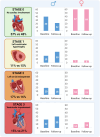Evolution of Cardiac Damage Staged With Echocardiography in Fabry Disease
- PMID: 40407053
- PMCID: PMC12229199
- DOI: 10.1161/JAHA.124.041627
Evolution of Cardiac Damage Staged With Echocardiography in Fabry Disease
Abstract
Background: Fabry disease can be classified in 4 stages based on the extent of cardiac damage assessed with echocardiography. This staging is strongly associated with prognosis, with a doubled risk increase of cardiovascular events for each stage progression. The aims of the present study were to investigate the evolution of cardiac damage using this staging system during midterm follow-up and to identify predictors of stage worsening.
Methods and results: This is a retrospective, multicenter study, which included 168 patients with Fabry disease (38% men) categorized at baseline and follow-up in 4 stages, defined as follows: stage 0, no cardiac involvement; stage 1, left ventricular hypertrophy; stage 2, left atrial enlargement; and stage 3, ventricular impairment. After a median of 5 years, cardiac stage worsened of at least 1 class in 34 patients (24% of 143 patients in stage 0-2 at baseline), improved in 9 (12% of 73 patients in stages 1-3 at baseline), and remained stable in 125 (74% of the 168 patients enrolled). At multivariable logistic regression analysis, age (odds ratio, 1.05 [95% CI, 1.01-1.09]; P=0.006), male sex (odds ratio, 4.26 [95% CI, 1.54-11.79]; P=0.005), classic phenotype (odds ratio, 4.95 [95% CI, 1.30-18.72]; P=0.018), and renal failure (odds ratio, 10.40 [95% CI, 1.57-68.77]; P=0.015) emerged as independent predictors of cardiac damage stage deterioration.
Conclusions: Fabry disease is associated with a high rate of progression of cardiac damage during midterm follow-up, with ≈24% of patients experiencing cardiac stage worsening. Age, male sex, classic phenotype, and renal failure are independent predictors of stage progression.
Keywords: Fabry disease; cardiac damage; echocardiography; hypertrophic cardiomyopathy.
Conflict of interest statement
Dr Lillo has received advisory board fees from Amicus Therapeutics, Sanofi Genzyme, Takeda, and Shire. Dr Biagini has received speaker fees from Amicus Therapeutics, Sanofi Genzyme, Takeda, and Bristol Myers Squibb. Dr Pieroni has received speaker and/or advisory board fees from Sanofi Genzyme, Pfizer, and Bristol Myers Squibb. Dr Limongelli has received advisory board fees from Amicus Therapeutics and an unrestricted grant from Sanofi. Dr Olivotto has received research grants from Bristol Myers Squibb, Cytokinetics, Sanofi Genzyme, Shire, Bayer, Amicus, Chiesi, and Menarini International; he has received also speaker and/or advisory board fees from Bristol Myers Squibb, Cytokinetics, Sanofi Genzyme, Amicus, Shire, Tenaya, and Rocket Pharma. Dr Graziani has received research grants from Takeda and Pfizer; she has also received advisory board fees from Amicus Therapeutics, Sanofi Genzyme, and Shire. Dr Pisani has received speaker fees from Amicus Therapeutics, Sanofi Genzyme, Takeda, and Shire. The remaining authors have no disclosures to report.
Figures


References
-
- Graziani F, Lillo R, Panaioli E, Pieroni M, Camporeale A, Verrecchia E, Sicignano LL, Manna R, Lombardo A, Lanza GA, et al. Prognostic significance of right ventricular hypertrophy and systolic function in Anderson‐Fabry disease. ESC Heart Fail. 2020;7:1605–1614. doi: 10.1002/ehf2.12712 - DOI - PMC - PubMed
Publication types
MeSH terms
LinkOut - more resources
Full Text Sources
Medical

